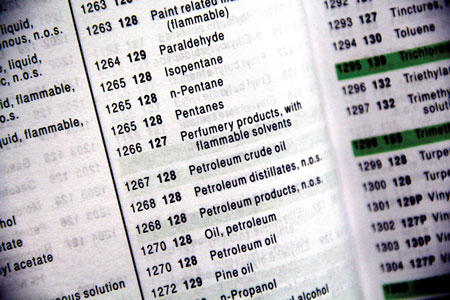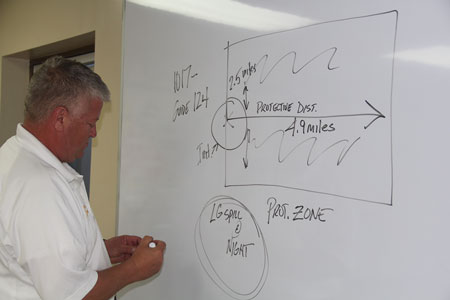
One of the driest things we do in the fire service is our annual hazmat refresher. There are two groups of firefighters: those who say IDLH means immediately dangerous to life or health and those who say IDLH means I don’t like hazmat. Whatever group you fit into, we need to be prepared to answer the call safely and efficiently. One of the most basic tools we have for responding to a hazmat call is the Emergency Response Guidebook (ERG). Ask those who have been on the job for a while if they know the ERG, and the answer is usually, “Oh yeah.” But, do they really know it?
When asked to do a refresher, I usually get the crew in the day room, give them an ERG, and get back to basics. I tell the students that the ERG is orange on the outside because it’s our job to get to the orange on the inside.
The first subject we cover is the Table of Placards in the very front of the ERG. We all know uphill, upstream, upwind, so our safest approach is from those categories. I ask, Where are we coming from and where are we going to? What did dispatch say we had? What rig are we taking? Our safest approach is staging far enough away so that we are not in the hot zone. If we are that far away, can we see product names or numbers? Maybe all we see is the color of the placard. If that’s the case, we use the Table of Placards to identify what guide number we go to. I mention that I usually choose the lowest number in the guide just to be on the safe side. Guides go from 111 to 172, in the order of decreasing hazard. The guides are presented in a two-page format; the left page covers potential hazards. Is it safe for us to even attempt to do anything, or do we direct the endangered people to a safe area and wait on a formal hazmat team? That page is where we start, and if we can’t get past it, then we wait.
The Plan Components
The top of the guide tells us the type of material with which we are dealing. We can start to formulate a plan. On the right side is what we do for public safety and emergency response. I remind the crew that you are number one, your partner is number two, and everyone else is number three. The first things we do are identify the material, make the appropriate notifications, and then protect ourselves and others. That is where the initial isolation and evacuation distances are mentioned. After we ensure our safety and that of our citizens, we research what we are to do for decontamination for us and the victims.
Next, we go to the railcar/road trailer pages. I ask, What shape is the railcar or road trailer? What’s in it? Is it corn syrup or methyl ethyl bad stuff? What is the guide number to the trailer or railcar?
After mastering finding where to go from there, we move to the color-bordered pages: yellow for identification by UN/NA number, blue for identification by name. Easy enough, huh?
 |
| (1) Photos by Dawn Young. |
I ask the crew to look up crude oil. Everyone knows that’s hazardous. Hmmmm … silence. I ask them to look up 1267. Wow! It’s really called petroleum crude oil! (photo 1). This is a great opportunity to stress safety data sheets so they get the correct name.
After that, we look up random things: fish meal, fire extinguishers, first-aid kits, London Purple, and discuss why those items are hazmat. Use your ERG to find any known products in your first-due area, and familiarize your crew with those products. You may be surprised at how much discussion on target hazards your crew comes up with. Remind your crew about the local emergency response plan and who the key players are. Let your crew come up with other resources on their own; that gives them ownership and pride in being part of the solution. You will notice the thought process coming together and the interest in coming up with real, everyday solutions that they own now and will remember.
After all of that, you will notice that the crew is actually having fun competing to find the answers to the questions you are asking. Their minds are off of thinking how dull the refresher is, and they are actually getting experience in using the ERG. There is much more to cover, but just by getting the crew “in the book” and hands on, they are interested and engaged.
Mitigation, What Ifs
We go to the guide pages and discuss what we have to do to mitigate a scene or anything we would need to do our job safely. Brainstorming about our wants and needs and what we can substitute for them in an emergency gets the crew thinking. What do we have for decontamination? Fancy store-bought stuff or mop buckets and truck scrub brushes? How will we get soap or bleach, and is it compatible with the product? What about runoff? Do we have kiddie pools, or can we make a catch-all with a salvage cover? (That leads to another drill.)
We go to the dry erase board or chalk board and map out protective action distances and zones (photo 2), and we talk about “what ifs.” How many people, schools, churches, businesses could be affected? What about evacuation or shelter in place? What are some evacuation routes we will tell the citizens to take? Are they trapped in an area we can’t evacuate, or are the routes leading them into harm’s way? How will we arrange for transportation for the victims? How will we notify the appropriate shelter-type building owners that we need their facilities, and will they allow us to send victims to them? An enormous amount of discussion on just that will ensue.

The next thing you know is that it has been a learning experience that we may not have realized. How much has the crew learned from the very informal training? My guess is much more than from a PowerPoint® presentation. We’ve all been in that class where all we want to do is sign the training roster and get the heck out of there. Getting the crew engaged, hands on the ERG; discussing the target hazards in our community; and fostering the camaraderie that comes from the friendly competition are priceless. When I close the drill out, I usually give them something to think about: What if it is your family who is affected by a release? How good will they think we are in mitigating a hazmat incident?
I usually end the drill with a little humor. I ask them to look up UN 3065 and tell me what to do if I accidentally ingest some of that product. I’ll leave it at that.
GRAY YOUNG, a 20-year veteran of the fire service, has worked in volunteer and career fire departments. He has been chief of training for South Bossier District Two, Louisiana, since 2002. He is the assistant manager of the Louisiana State University Fire and Emergency Training Institute. He is president of Brothers of the Boot, a F.O.O.L.S. chapter.
Fire Engineering Archives

